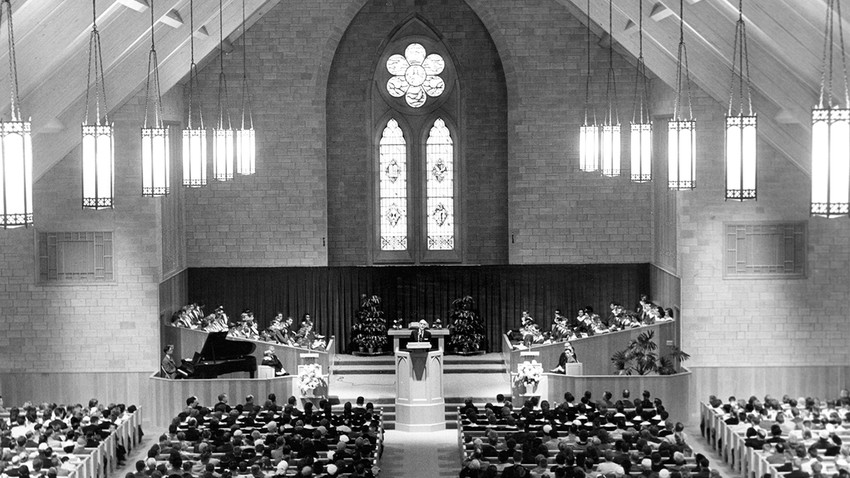
When History Is His Story
Some have attributed to Confucius the proverb, "A picture is worth a thousand words." So let's share a 5000-word history (five pictures) that ends with the birth of the Pioneer Memorial Church exactly sixty years ago right now—captured in five black and white photographs, mounted on the back wall of our sanctuary, each with a gold plaque of explanation—all of them a gift of the Emmanuel Missionary College Class of 1953. Take a look:
Photograph #1—the old Berrien County Courthouse. The plaque reads:
On October 31, 1901, the faculty and students organized the Emmanuel Missionary College Church. The charter listed forty-one members, the organizers being Sutherland and Haughey [two faculty members]. Religious services were first held in the vacant Berrien County Courthouse the first school year of Emmanuel Missionary College in 1901 through 1902. On December 5 the church opened a church school for sixteen pupils, using the first floor of the courthouse [still standing in the middle of our village today].
Photograph #2—the original EMC Administration Building (1903-24):
This building was the fourth structure to be built on the campus. It held primarily administrative offices and was the only building kept warm enough for student study. [Wonder how they would have fared with the recent polar vortex!] The chapel room served as the home of the EMC campus church. The onion dome [see the photograph] housed the campus bell used at Battle Creek College [now in Nethery Hall]. The building was razed in 1953—the same year the Student Association initiated a campaign for a new campus church.
Photograph #3—Auditorium Basement (1924-26):
Beginning in early 1924, the basement of the unfinished Auditorium building served as the next home of the church. There was seating for 600 people in this room. . . . Nature spurred completion of the Auditorium. A February-Sabbath thaw almost disrupted the church service when the "entire north side of the chapel was flooded within two rows of the front." Umbrellas shielded the worshipers from the dripping water [is this beginning to sound familiar—some things never change!] during the rest of the service.
Photograph #4—Auditorium (1926-1959):
"The wooden chapel will be in keeping with the faith of the denomination, looking forward to the near coming of our Lord and Master, and at the same time providing seating capacity with galleries for about 850 people. The student capacity will be provided on the main floor for 500 only, and it is hoped the school will not grow beyond this number," commented Board Chairman William Guthrie [ninety-three years later we ruefully smile at his awkward hope and prediction, while recognizing his passion must yet be our passion, too]. Not exclusively dedicated to worship services, secular gatherings were also held in the Auditorium. For 20 years the basement was used as a recreation hall for games and receptions.
Photograph #5—Pioneer Memorial Church "An House of Prayer for All People" (1959- ):
The Student Association of 1953 spearheaded a fund-raising campaign for what would become the only campus building dedicated solely to divine worship. Bake sales along U.S. 31 benefited the fund, as did the systematic giving of hundreds of people. When the work on the church was ordered stopped temporarily for lack of funds, a number of plant service men donated full weeks of time to prepare the church for the opening service Sabbath, February 14, 1959. By May 21, 1960 everything except the pipe organ was ready for dedication. On March 12 and 13 of 1966 the Casavant organ, with its 4,233 pipes, was unveiled. The name, Pioneer Memorial Church, bears witness to the educational talents of illustrious instructors or lecturers in our past.
Five photographs, one history—and it's your history and mine as members of this now sixty-year-old church family. A history with God's fingerprints all over it. Which is why we must keep singing the Doxology and telling the story, "so the next generation will know [God's mighty acts], even the children yet to be born, and they in turn will tell their children. Then they will put their trust in God and will not forget His deeds but will keep His commandments" (see Psalm 78:6-7).
When history is His story—pass it on!